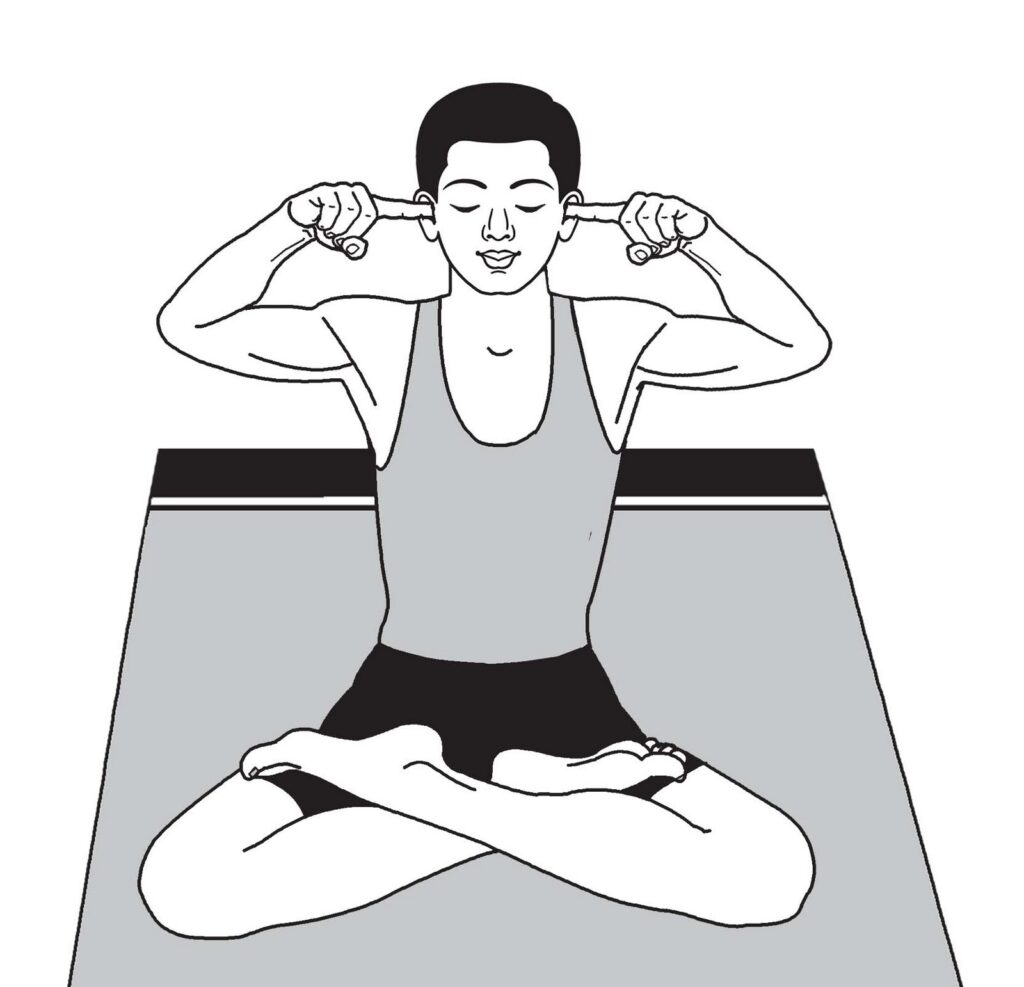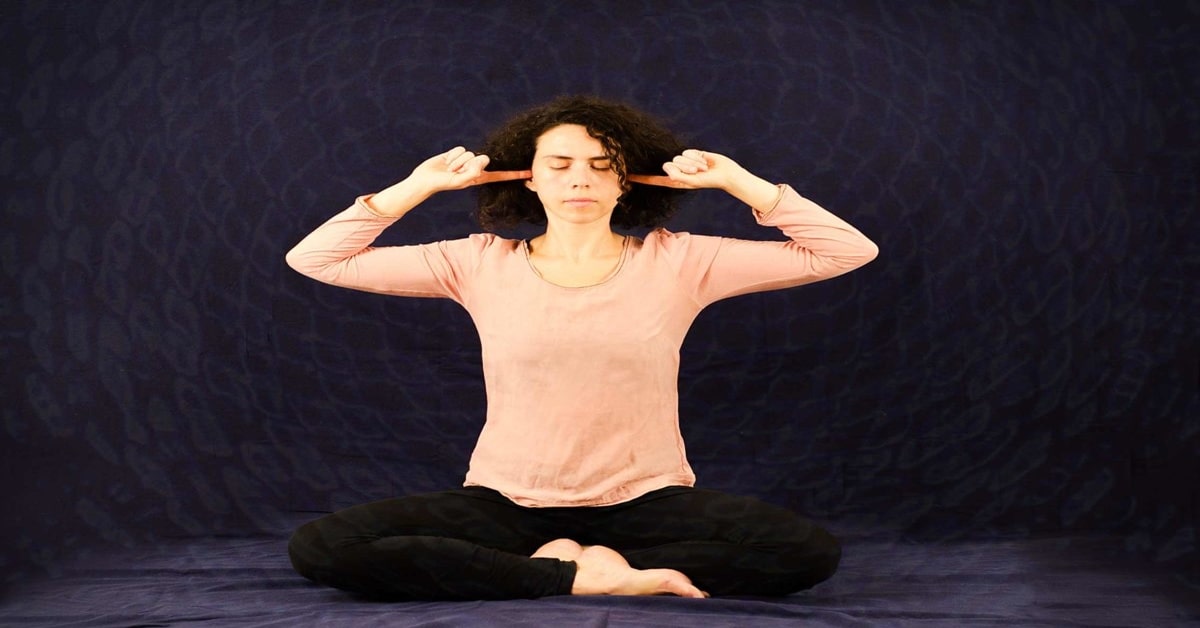The Sanskrit word Bhramari means “bee.” Therefore, Bhramari Pranayama is pranayama where the sounds produced while performing it are similar to one made by a black bee.
It is amazing pranayama to relax the mind and improve sleep quality. Let’s learn about it in more depth.
What is Bhramari Pranayama? (Mention in Scriptures)
In Hatha Yoga Pradipika, a 15-century seminal scripture of Yoga, the following is mentioned about Bhramri Pranayama

Bhramari Pranayama in English
Translation: “Breathe in quickly, making a reverberating sound like the male black bee, and exhale slowly while softly making the sound of the female black bee. By this yogic practice one becomes lord of the yogis and the mind is absorbed in bliss” [1].

After learning about its meaning from the scriptures, let us understand the steps involved in performing Bhramri.
Bhramari Pranayama Steps (humming bee breath)
- Sit in a comfortable meditative posture. You can sit on a chair or in padmasana or siddha asana.
- Your spinal cord and head should be erect, and the hands should rest on the knees in the chin or jnana mudra.
- Now close your eyes and relax your whole body. Calmly observe your breath for a minute to relax and centre yourself.
- The lips will be closed and maintain a small gap between the teeth throughout the practice.
- This small gap ensures that the bee’s sound or vibration made during the practice is felt more prominently in the brain.
- Make sure that throughout the practice your face muscles and jaws remain relaxed.
- Now raise both your arms sideways and bend your elbows and bring your hands to your ears. Use your index or middle finger to plug your ears (Fig. 1).
- Don’t close your ears too tightly or insert your finger inside the ear. Just gently place your finger on the flap of the ear and press the flap inside the ear opening. Or you can put your fingers gently above the ear opening.
- Bring your awareness between your eyebrows and keep the body still and calm.
- Take a deep breath through your nose. Now exhale slowly and while exhaling makes a deep, steady and continuous humming sound throughout the exhalation. The sound should be soft and resonate within the whole skull.
- This completes 1 round. Again, take a deep breath and repeat the process from step 10.
Throughout the practice ensure that the awareness remains on the humming sound and the breath remains even and steady.
Bhramari pranayama how many times?
- Do the practice for 9 rounds or 9 deep breaths.
- In the beginning min, 5 to a max of 10 rounds are sufficient.
- This is harmless pranayama as it involves slow breathing.
- In cases of extreme tension or uneasiness like anxiety, this practice can be extended up to 15 to 20 minutes.
Best time to practice?
- The best time to practice is in the evening/night or early in the morning.
- This is because other distractions during these times are minimum.
- However, in the case of relieving mental stress, this pranayama can be practised anytime.
Advance Variation
- This variation should only be performed once you have been doing pranayama for a long time and have gained experience in breath retention and bandhas.
- Pactice in the same way as the above procedure describes, but after you inhale, perform bahir kumbhaka and jalandhara bandha.
- Same as above in the beginning perform min 5 to max 10 rounds. Take a few normal breaths between rounds if it feels necessary because of the retention.
Side Effects of Bhramri Pranayama
- People with ear infections should not practice this pranayama until the infection is healed.
- People suffering from high blood pressure and heart diseases should perform this pranayama gently, slowly and without any breath retention.
- Don’t press your ears tightly or insert your fingers inside the ear too deep.
- If having severe anxiety, it is better to take a doctor’s advice along with practising this pranayama.
Bhramari Pranayama Benefits (Fayde)
- It helps in relieving stress and tension in the mind and body.
- It helps in the alleviation of anger and anxiety issues.
- It helps in curing insomnia.
- It helps in reducing blood pressure.
- It helps in strengthening and improving the quality of voice.
- It helps in eliminating throat ailments.
Bhramari Pranayama and Nitric Oxide
There is emerging evidence of the positive impact of Bhramari due to increased expression of nitric oxide (NO) and its impact on oxygen uptake.
Human paranasal sinuses produce a large amount of NO continuously and humming sound vibrations create air oscillations which in turn increase the exchange of air between the sinuses and the nasal cavity.
Recent findings indicate that increased nasal NO could play an important role in the prevention and management of COVID-19 since NO is anti-inflammatory and contributes to non-specific host defense against bacteria, viral, fungal, and parasite infections
Science Direct Research Paper [4]
Learn about more Pranayamas in this section.
References
- Book: Hatha Yoga Pradipika: Light On Hatha Yoga, commentary by Swami Mukti Bodhananda
- Book: Hatha Yoga – The report of a personal experience, by Theos Bernard
- Research Paper: Effects of Bhramari Pranayama on health – A systematic review (link)
- Research Paper: Bhramari Pranayama – A simple lifestyle intervention to reduce heart rate, enhance the lung function and immunity

1 thought on “Bhramari Pranayama – Steps, Benefits, Side-effects & Nitrous Oxide”